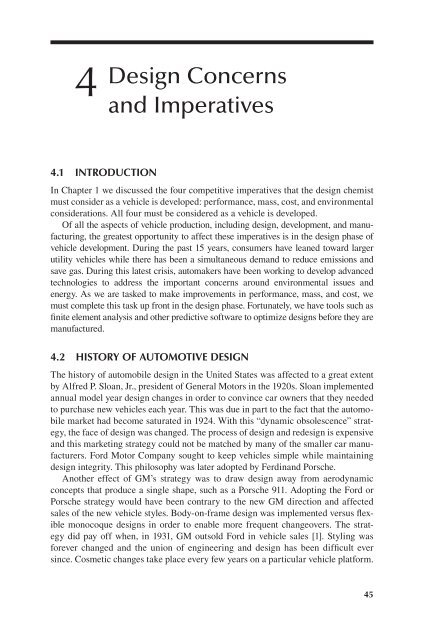THE ROLE OF THE
THE ROLE OF THE
THE ROLE OF THE
You also want an ePaper? Increase the reach of your titles
YUMPU automatically turns print PDFs into web optimized ePapers that Google loves.
4<br />
4.1 IntroductIon<br />
Design Concerns<br />
and Imperatives<br />
In Chapter 1 we discussed the four competitive imperatives that the design chemist<br />
must consider as a vehicle is developed: performance, mass, cost, and environmental<br />
considerations. All four must be considered as a vehicle is developed.<br />
Of all the aspects of vehicle production, including design, development, and manufacturing,<br />
the greatest opportunity to affect these imperatives is in the design phase of<br />
vehicle development. During the past 15 years, consumers have leaned toward larger<br />
utility vehicles while there has been a simultaneous demand to reduce emissions and<br />
save gas. During this latest crisis, automakers have been working to develop advanced<br />
technologies to address the important concerns around environmental issues and<br />
energy. As we are tasked to make improvements in performance, mass, and cost, we<br />
must complete this task up front in the design phase. Fortunately, we have tools such as<br />
finite element analysis and other predictive software to optimize designs before they are<br />
manufactured.<br />
4.2 HIstory oF automotIve desIgn<br />
The history of automobile design in the United States was affected to a great extent<br />
by Alfred P. Sloan, Jr., president of General Motors in the 1920s. Sloan implemented<br />
annual model year design changes in order to convince car owners that they needed<br />
to purchase new vehicles each year. This was due in part to the fact that the automobile<br />
market had become saturated in 1924. With this “dynamic obsolescence” strategy,<br />
the face of design was changed. The process of design and redesign is expensive<br />
and this marketing strategy could not be matched by many of the smaller car manufacturers.<br />
Ford Motor Company sought to keep vehicles simple while maintaining<br />
design integrity. This philosophy was later adopted by Ferdinand Porsche.<br />
Another effect of GM’s strategy was to draw design away from aerodynamic<br />
concepts that produce a single shape, such as a Porsche 911. Adopting the Ford or<br />
Porsche strategy would have been contrary to the new GM direction and affected<br />
sales of the new vehicle styles. Body-on-frame design was implemented versus flexible<br />
monocoque designs in order to enable more frequent changeovers. The strategy<br />
did pay off when, in 1931, GM outsold Ford in vehicle sales [1]. Styling was<br />
forever changed and the union of engineering and design has been difficult ever<br />
since. Cosmetic changes take place every few years on a particular vehicle platform.<br />
45







